Revisiting design thinking and the Library Test Kitchen course at Simmons from the student perspective.
“Who has heard of design thinking?” asked my 438 (Introduction to Archival Methods and Services) professor. I eagerly raised my hand, along with two other students who half-raised their hands, half shrugged their shoulders. After watching a section of the documentary film, Design & Thinking, our class collectively brainstormed a series of challenges associated with the finding aid, such as lack of accessible formats or that they are too often veiled by archival jargon. Then, we divided into groups and were tasked to “redesign the finding aid” by choosing one of the problems and come up with possible solutions. My professor encouraged us to push past the idea of the finding aid as an archivists’ tool and imagine it as something completely different. Our class didn’t reach this point, which makes complete sense and adds further proof to the notion that design thinking is truly a holistic process and even more importantly, a mindset that one needs to adopt. It takes time to settle into a completely new concept, especially one that comes out of the design world, which many students and LIS professionals may feel very far removed from.
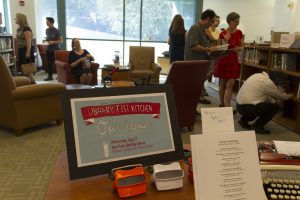
I only knew about design thinking because of my research of and work with the team behind the Library Test Kitchen at Simmons School of Library Information Science course, which was offered during the 2016 summer session and is coming back for Summer 2017. I feel privileged to have had knowledge of design thinking swirling around in my mind since September. It is a valuable framework to have access to and a way to approach problems in new ways. If you want to read more about some of the history and fundamentals of design thinking, please see my previous post on the topic.
The original Library Test Kitchen team from Harvard University and Olin College, LTK@Simmons instructor, Candy Schwartz, and Simmons’ Dean Eileen Abels along with Lynne Howarth and Linda Smith, were invested in producing some sort of synthesis of the LTK@Simmons experience from both the student and instructors perspective. This is how my first article about design thinking came to be and this second article incorporates more direct feedback from students. In addition to these written pieces, everyone came together to help produce a short movie about the Library Test Kitchen course at Simmons. Abels, Schwartz, Howarth and Smith, gave a workshop on teaching design thinking at ALISE 2017. Abels, Howarth and Smith are the leaders of a project dedicated to future-focused LIS education and you can read more about that project at this website. I am excited to see that LTK@Simmons is being offered again this summer and only wish that I could take it! My friend and fellow SLIS student Lindsay Deal told me she is taking Library Test Kitchen and when I asked why she signed up for this course, she said:
“I am curious about the design aspect of everything, particularly of libraries…I am also interested in the design of organizing space and information in general. I’m in the IS&T (Information Science and Technology) track and I haven’t taken a library centric class yet, so I’m very excited that this course will be more library focused.”
I also asked her if she had heard of design thinking and if she knew what it meant. She answered that she was not too familiar with the concept but when prompted to come up with a definition, she said that it is about “making things, making something better…making things the most optimal that they can be and making the most efficient use of space.” I’m excited to compare and contrast the first iteration of LTK@Simmons to this summer’s upcoming course. But for now, let’s dive deeper into the experience of LTK@Simmons 2016.
Students Reflect on LTK@Simmons 2016
Students in LTK@Simmons were tasked with proposing a project idea and then building a prototype that would in someway “reflect and respond to the needs of diverse communities and stakeholders” in the context of library services. The students also had to identify their minimum viable product (MVP), meaning what they actually would have at the end of the course. MVP is a “bare bones” product that still has enough features and value to generate user feedback and satisfy early adopters. This assignment produced a wonderful spread of different projects and at the Project Fair, students showcased their MVPs. A small sampling includes:
In addition to the student interviews that Jeff Goldenson, director of the Olin College Library and instructor of LTK@Simmons, filmed on the final day of class, I sent out a questionnaire to students, asking for further feedback. My first question on the survey was, “Why did you take this course?” Personally, before knowing about design thinking, I would have been pretty intimidated by the concept of designing and prototyping things. I wanted to know what pushed library students to explore such a course. Molly Rogers said, “I thought this course more than many at Simmons focused on what the future of libraries might tangibly look like. I was excited about thinking about libraries from a different perspective” while another student, Kayla Larkin, had heard about the original course at Harvard so she “was completely psyched when [she] learned that it was coming to Simmons.” Based on Goldenson’s footage, many students echoed Kayla and Molly’s sentiments about wanting to experience something tangible and apply theoretical concepts about users and libraries by actually doing.
Jessica Yurkofsky, Jeff Goldenson, Jeffrey Schnapp and Matthew Battles (instructors and/or students involved with all iterations of LTK) may be trained as designers but they also have an intensely passionate dedication to the library. Speaking with them helped me realize that one of the most important aspects of embracing the design thinking process is that you must abandon personal assumptions that would impede your own creativity. This means that anyone can be creative and anyone can be a designer but you must shed the idea that you can’t, that you aren’t a “creative person.” David Kelley, founder of IDEO and a major reason design thinking became more mainstream, shares this sentiment.
Meg Blakemore, a school librarian and LIS PhD student, expressed concerns about her abilities: “Once I read the syllabus, I really questioned my ability to do some of the things we were going to be expected to do. My background is not in design or in the arts at all, and some of the tasks were a little intimidating at first glance.”
Another key element to the design thinking process and mindset is that of group dynamics. In order to be at your most creative, you have to be willing to make mistakes and not be concerned with others judgement. This kind of environment can only exist once mutual respect is built between students and instructors. Especially something like design, which is outside many people’s comfort zones, is going to feel quite challenging and even frustrating at times. Meg, Molly and Kayla all cited their classmates and instructors as instrumental to their personal success and success of the course. Meg said, “The activities did test and stretch me, but the instructors provided support and flexibility so we were all able to succeed….I was surprised at how much the class gelled and became a community. We were all teachers and learners.” To see that Meg felt this way is really encouraging, because that’s exactly the environment Jessica Yurkofsky set out to create. Jessica herself was a student in the Harvard Library Test Kitchen course, then she became an instructor but continued to learn from her students.
One of my favorite things that Candy Schwartz said about design thinking is that “there is no box!” referencing the popular saying, “Think outside the box!” This is perhaps why there has been some pushback and criticism of Design Thinking. I capitalize it here because IDEO, the global design and consulting firm, has definitely turned Design Thinking into a kind of product package and brought it into the corporate world. There are toolkits for educators, librarians and businesses on how to hold a Design Thinking session with colleagues. However, marketing design thinking as a an enclosed, complete package is antithetical to the idea and principles behind design thinking. I’ve also heard and read people criticizing firms like IDEO making design thinking out to be this brand new, hip “thing” when in reality, it was first mentioned in an engineering book in 1965. Along this same vein, critics (mostly those with a design background) don’t like how it has become a buzzword to be thrown around in certain spheres, inevitably is misused, and therefore loses credibility and meaning.
While I cannot speak for the design and business world, based on feedback from LTK@Simmons and the use of design thinking in libraries, it is still an incredibly valuable endeavor to teach and learn about this process. Watching the interviews from the final day of class, you can really feel the enthusiasm, passion and respect the students had for themselves, their peers, their projects, and their instructors. One student said that “Library Test Kitchen is a necessary course” for library school students and many others proposed that it would be wonderful to turn it into a semester long course. It is clear that students crave a way to turn theory into action before entering their professional careers because there is still room for big and crazy ideas, as well as the ability to make mistakes.
Student Quotes

“This kind of class was so good….taking things from theory into the physical space is hard to do! Having people outside of librarianship and outside the academia of librarianship was super helpful…interacting with people, doing just anything you want to do making communities….This course is what the core of libraries is because you can get to the community and have other people have ideas and really engage with your patrons, with your patron community. A+ times a million”
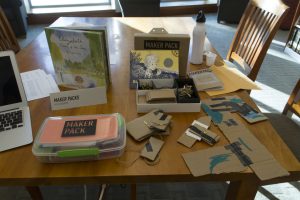
“I feel like it [the course] answers the question of why I’m doing this degree, what could a library of the future that actually appeals to people, be? That was kind of the question I hoped to answer with all of the classes I took like what is going to make people come to the library and care about the library? The design was hard for me…but I was so happy with how my end project turned out that I mean it was a cool challenge.”
“I think so much of what we do is focused on the practical application of things and we don’t really move outside of ourselves and libraries….design is an important way to make things more accessible and to make things easier to approach and understand, and I think this was a great class to helps us move outside of ourselves and think about things in a different way.”
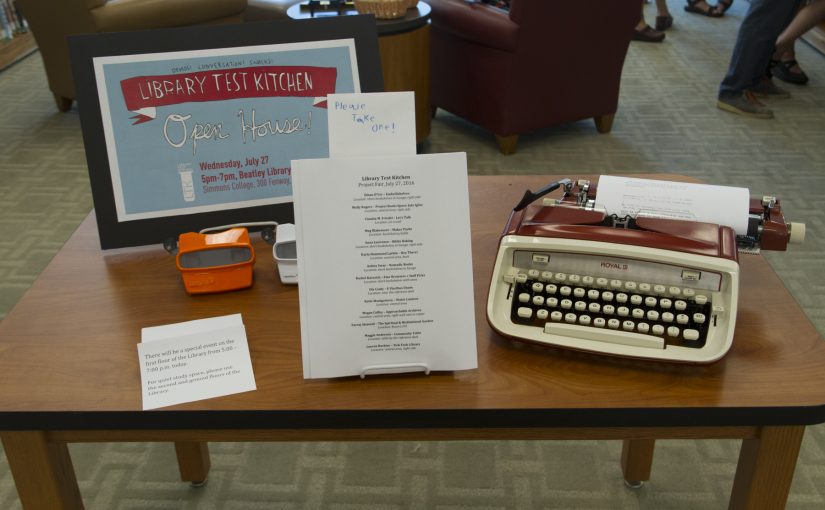
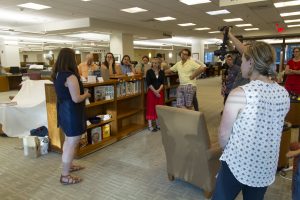
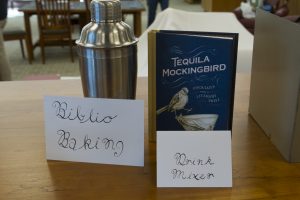
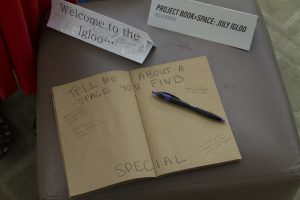
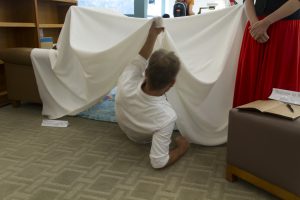
Content was very useful.